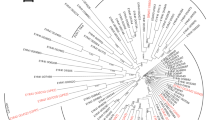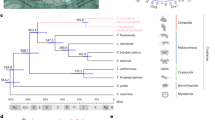Abstract
ALTHOUGH most fungi that parasitise arthropods are relatively harmless, many can penetrate different types of cuticle1. Thus active defence mechanisms presumably operate in vivo. In crayfish, for example, resistance to fungal penetration is associated with melanisation of the cell wall of the fungus by host phenols and phenoloxidase2. This constitutes a system for recognising the invading organism at different levels, from the cuticle surface inwards3. Melanisation in insect blood, due to phenoloxidase activity, is also induced by the presence of cells or cell walls of fungi4,5. Crayfish phenoloxidase in cuticle and blood is highly and specifically activated in contact with the purified hyphal cell walls of most fungi but not with other plant cell walls6. We have now found that soluble β-l,3-glucans from fungal cell walls activate the enzyme and may serve as specific elicitors of recognition in crayfish of invading fungal parasites.
This is a preview of subscription content, access via your institution
Access options
Subscribe to this journal
Receive 51 print issues and online access
$199.00 per year
only $3.90 per issue
Buy this article
- Purchase on Springer Link
- Instant access to full article PDF
Prices may be subject to local taxes which are calculated during checkout
Similar content being viewed by others
References
Unestam, T. Rev. med. vetr. Mycol. 8, 1–20 (1973).
Unestam, T. Austral. J. exp. Biol. med. Sci. 53, 349–359 (1975).
Unestam, T. & Nyhlén, L. Contemp. Topics Immunobiol. 4, 189–206 (1973).
Pye, A. E. Nature 251, 610–613 (1974).
Vey, A. & Götz, P. Parasitology 70, 77–86 (1975).
Unestam, T. & Beskow, S. J. invertebr. Pathol. 27, 297–305 (1976).
Unestam, T. J. invertebr. Pathol. 27, 391–393 (1976).
Fleet, G. H. & Manners, D. J. J. gen. Microbiol. 94, 180–192 (1976).
Jawetz, E., Melnick, J. L. & Adelberg, E. A. Review of Medical Microbiology (Lange Medical, Los Altos, California, 1975).
Yoshioka, Y., Emori, M., Ikekawa, T. & Fukuoka, F. Carbohydrate Res. 43, 305–320 (1975).
Anderson-Prouty, A. J. & Albersheim, P. Pl. Physiol. 56, 286–291 (1975).
Ayers, A. R., Ebel, J., Finelli, F., Berger, N. & Albersheim, P. Pl. Physiol. 57, 751–759 (1976).
Author information
Authors and Affiliations
Rights and permissions
About this article
Cite this article
UNESTAM, T., SÖDERHÄLL, K. Soluble fragments from fungal cell walls elicit defence reactions in crayfish. Nature 267, 45–46 (1977). https://doi.org/10.1038/267045a0
Received:
Accepted:
Issue Date:
DOI: https://doi.org/10.1038/267045a0
This article is cited by
-
Exocytosis of the prophenoloxidase activating system from crayfish haemocytes
Journal of Comparative Physiology B (1985)
Comments
By submitting a comment you agree to abide by our Terms and Community Guidelines. If you find something abusive or that does not comply with our terms or guidelines please flag it as inappropriate.



